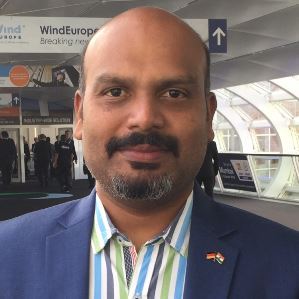Offshore Wind in Asia I: Insight into Core Markets
Currently, offshore wind development in Europe experiences a bit of a lull. Recent figures on development forecast a further decrease in new installations for the next years. With the traditionally strong nations on the European offshore wind market flagging, investors are looking for new opportunities. Several countries in Asia are pushing offshore wind development, making them an attractive option for investors worldwide.
This is the first in a series of posts on the topic Offshore Wind in Asia, which will be published over the next few months. Having supported projects in a large part of Asia, we have gained some first-hand experience of those markets. We want to share it with you here at WindGuard Insight. In this first post, we will take a look at the market conditions in different Asian countries. We will be highlighting the risks and challenges as well as the chances each country has to offer.
CHINA
Because of its long coast-lines, China has great potential for offshore wind. Environmental conditions vary greatly, including some areas under significant threat from typhoons. But with Chinas ever-growing appetite for electricity, offshore wind is a fixed part of the targeted energy mix. After first offshore projects in 2010, development slowed down in the following years. Since 2016, Chinas has significantly picked up speed. That led to a total installed offshore wind capacity of 4.5 GW by the end of 2018. A further 6.5 GW were approved in 2019. Politics plan to reach 10GW until 2020, and aim for 60 GW in the long term.
High ammount of local content and different project setup
Developments in China, however, mostly go past international players. As part of the political strategy, China keeps its projects as local as possible. Project owners, for example, are exclusively Chinese companies. The completely different setup in terms of financing, ownership and interfaces poses additional difficulties for international players. For example, project finance as it is common in the western world is not existent in China.

chuyuss/Shutterstock.com
Developer and investor of a project are usually one and the same, and – with very few exceptions – state-owned enterprises. Loans are granted against parent guarantees in form of mortgages or credits. Interfaces between OEM and operator are different as well. Turbine installation not being the responsibility of the OEM (they only supervise) is one example of many. Adding the language barriers, a pressure of cost reduction and a rather crowded market to the list, obstacles seem very high.
Aim for FIT-free grid parity until 2021
All these factors make entering the market very difficult for international players. In 2018, a major change in the regulatory framework further complicated things for foreign companies. The previous feed-in tariff system – partly reliant on a surcharge per kWh raised from industrial electricity consumers – was very successful. But with more and more renewables claiming subsidies, the collected funds were no longer sufficient, leading to a massive gap in funding. The Chinese government reacted by aiming for FIT-free grid parity until 2021 and making all new projects from 2019 onwards subject to auctions. The change to a tender system has not had any effect yet, but that is expected to change in 2020.
TAIWAN
Side-note: the third part of our series “Offshore wind in Asia” will take a more in-depth look at the project setup and the environmental challenges in Taiwan. Stay tuned!
In comparison to China, the situation looks very different in Taiwan. Nowhere on the wind map five years ago, Taiwanese law-makers set the ambitious goal to reach 5.7 GW until 2025. Just a few weeks ago, during the inauguration of Formosa 1 (see below), news outlets reported of government plans of a further 10GW between 2026 and 2035. Currently the installed capacity is at 128 MW. As Taiwan is heavily reliant on importing electricity to satisfy the growing demand and has decided to phase-out nuclear power by 2025, the political necessity for more renewables is there.
Solid political framework
So Taiwanese law-makers not only set high aims, but followed them up by providing the feed-in structure to push development accordingly. In 2012, the government set up the Offshore Wind Power Demonstration Incentive Program (DIP), for which three projects were chosen as demonstrators in 2013. These demonstration wind farms were supported by government subsidies to get offshore wind in Taiwan going. After one farm lost its demonstrator status, two projects, Formosa 1 and TPC, with a combined capacity of 238 MW remained. Installations on Formosa 1 were completed in October 2019. With its official inauguration earlier in November, it added 120 MW to Taiwan’s offshore capacity. TPC is in the installation phase and will be commissioned in2020. A further 5.5 GW of projects have been allocated grid connection.
Successful partnerships between national and international players

In the set-up of national and international players, Taiwanese government again takes a different approach than their Chinese neighbors by encouraging partnerships between the local industry and experienced international project developers, especially in the early projects. Political framework aims at building a national offshore wind industry step by step, thus creating local content over time. This approach seems to pay off, especially as environmental conditions in Taiwan make it a difficult terrain to operate in – even for veteran developers.
Difficult environmental conditions make offshore projects challenging
While the long coast-lines make offshore wind a logical choice, conditions are technically challenging. In comparison with European North Sea conditions, the projects are facing strong current and wave environments as well as earthquakes and typhoons. This is a challenge not only for foundation and tower design, but also for the turbine site verification as well as installation and maintenance. Projects become technically more challenging as these risks for technical implementation have to be factored in. However, despite all difficulties, both demonstrator projects already have shown so far: offshore wind in Taiwan is possible. With respective political will and financial incentives, they can be implemented in a shorter amount of time than any average European project. However, they may come at a higher cost and with more collateral along the way.
KOREA
In an comparably earlier stage than China and Taiwan, Korea is still worth to keep on the watchlist. With currently three projects of a total capacity of 38 MW operating in the demonstrator phase, an additional 60 MW are currently in installation. Just as Taiwan, Korea depends heavily on external energy supply, importing over 90% of their demand. According to their latest plans, South Korea sets itself the target to reach a share of 35% of renewables by 2040.
Fast increasing water depths

syeols/Shutterstock.com
As the local wind industry is not as developed yet, there is a need to bring in expertise and know-how from external consultants. However, technical knowhow for Koreas special needs is hard to come by. Because of the fast-increasing water depths, the country places a special emphasis on floating wind. There is not much long-term experience with this specific kind of technology yet. So far, demonstrator parks have shown the technical feasibility. The profits and cost-effectiveness of floating wind have still to be determined.
Big floating wind plans in the future
Nevertheless, a consortium between Norwegian developer Equinor and Korean partners went public in July 2019 with the plan to develop a 200MW floating wind farm in South Korea. Dependent on the turn out of a feasibility study, construction would be starting in 2022. If the project is realized, it will be the world’s biggest floating wind farm to date. All in all the market seems to have potential, but with floating as a technology still under scrutiny, it also has some significant economic risks.
JAPAN
Just like Korea, Japan has long coast lines, but also quickly increasing water depths, which make it a candidate for floating wind as well. Until earlier this year, poor grid infrastructure and the lack of any political initiative made it relatively uninteresting for developers. Consequently, only 18 MW are currently installed offshore. The political target, however, is to get this up to 10GW (combined for on- and offshore wind) in 2030.
Offshore wind promotion act
In spring 2019, law-makers in Japan finally passed the offshore wind promotion act which sets up a stringent schedule to push offshore wind in the country. Leases will be granted in a two-step process, were Japanese government will first designate zones on which developers can then bid. The winners will be granted a lease and an FIT approval. According to schedule, zones will be designated until 2020 and bid winners will be selected in 2021. This schedule and the development target are ambitious, but the administrative set-up seems sound.
International involvement is encourages

The Japanese administration is very much aware of the deficiency of its national industry and therefore encourages the involvement of international companies in the auctions. Proven experience in overseas projects will have a beneficial effect in the auctions. The opportunities for foreign players are plenty, as experience is as much missing in development as in engineering, procurement and construction. Suppliers and marine companies have a good chance as well as the supply chain is still missing some links.
INDIA
Last but not least, there is India. With a long history in onshore wind, there are currently no installed offshore turbines yet. However, the administration has set an ambitious target of 30GW installed offshore capacity until 2030.
Offshore wind started in India in 2014, when the government teamed up with the European Union and announced the FOWIND project (Facilitating Offshore Wind in India). FOWIND identified the wind potential along Indian coasts and narrowed it down to two areas in Gujarat in the northwest and Tamilnadu in the south and a potential of 100GW in total. A thorough study of the met-ocean conditions, bathymetry, wind conditions, availability of erection equipment, logistics and evacuation infrastructure was conducted by National Institute of Wind Energy (NIWE) and the Ministry of New and Renewable Energy (MNRE).
Steady political development with delays in the final stages
FOWIND was followed by FOWPI (First Offshore Wind Project in India) in 2016, in which the regulatory framework was developed. That led to the first prequalification process in 2018. Originally, tender documents for the first 1 GW wind farm were supposed to be published by the end of 2018. The tender would be open to international OEMs and investors. Around 30 players had already expressed interest to participate. For several reasons, for example the elections, political proceedings were delayed and the tender is yet to be published. Industry insiders have high hopes that tender documents will be published before the year 2019 is through. The timeline for reaching the target, however, is not seen as very realistic.
More challenges lie ahead
Apart from a slow moving administration, the investors will be faced with more challenges when thinking about the Indian offshore market. Environmental conditions are challenging. The average wind speeds between 7 and 7.5 m/s are relatively low, but technical requirements are high because of serious risks of cyclones. Interfaces are again different from European set ups and the market is highly price sensitive and competitive. India also already has a highly developed onshore wind industry, making it harder for global players to enter.
Subsidies through gap funding

Power purchase prices are expected to be around 4 INR /kWh (approximately 0.05 €/kWh). In addition to project financing by lenders, MNRE will provide a Viability Gap Funding (VGF) as a one-time subsidy. The funding will be limited to a maximum of 20% of the initial project cost. VGF has a set budget of 800 Mio € which will be distributed among all investors. Only time can tell, whether this will be incentive enough for international investors to buy into Indian offshore wind.
CONCLUSION
Generally speaking, Asian countries are dipping their tows into offshore wind waters and are willing to learn from others. As Asia was mainly not on the map of the oil and gas industry, there is no noteworthy offshore industries or companies with experience they could fall back on. That provides international offshore experienced companies with great opportunities.
Based on the experience gained from the strong involvement in European offshore wind farms Deutsche WindGuard has already provided support for offshore projects in India, China and Taiwan. Our daughter companies in Chennai (India) and Beijing (China) provide additional local expertise for the projects.
But is Asia really the future for offshore wind? Asian governments see the need to break away from fossil and nuclear energy. That is reflected in the ambitious development goals and first prerequisites. But with the challenging environmental conditions, the political framework will play an essential role in success or failure of offshore wind in Asia.
Cornelia von Zengen was Head of PR and Marketing at WindGuard Group for many years. She loves writing and the fresh sea breeze on her face on the Frisian coast. As her professional journey has made her sail to new shores in the meantime, we would like to take this opportunity to thank her once again for her contribution to the success of WindGuard Insight.
Co Authors :





